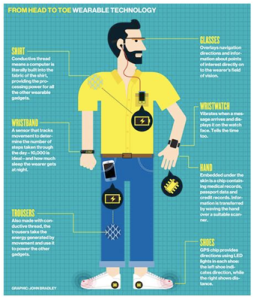Post by Abi Weaver, director of the Global Technology Project
Every so often, we have to pay homage to a good old-fashioned Buzzfeed-esque “top 10” list. Or, in this case, 11. Today, we count down the many ways wearable technology can do good in disasters.
 And by wearable technology we mean mini computers and sensors embedded in your watches, jewelry, clothing, shoes, backpacks, headwear, eyewear, prosthetics and medical implants, temporary tattoos, body cameras and basically just about everything else that attaches to your body, leverages your mobility and can be operated hands free. If this list isn’t long enough, TechCrunch has shared an entire periodic table dedicated to wearable technology.
And by wearable technology we mean mini computers and sensors embedded in your watches, jewelry, clothing, shoes, backpacks, headwear, eyewear, prosthetics and medical implants, temporary tattoos, body cameras and basically just about everything else that attaches to your body, leverages your mobility and can be operated hands free. If this list isn’t long enough, TechCrunch has shared an entire periodic table dedicated to wearable technology.
The American Red Cross began exploring wearable technology applications back in 2014 along with other emerging technologies like 3D printing, drones and robots. We’ve been actively connecting with entrepreneurs and other tech savvy groups developing software and hardware solutions that can support people’s future disaster-related needs. Here are 11 of our favorites.
Full descriptions of each idea are available at www.tech4resilience.org.
Preparedness applications for wearable technology
1. Early warning of threats and hazards
2. Simulating disaster scenarios
3. Controlling other electronics, such as remotely shutting off gas lines
Response applications for wearable technology
4. Navigating through an evacuation
5. Searching and rescuing
6. Reconnecting separated families
7. Assisting the disabled with emergency messages
Recovery applications for wearable technology
8. Tracking lost pets
9. Diagnosing and treating illnesses and injuries
10. Translating conversations and signs
11. Charging and connecting your other devices
There you have it – 11 of our favorite ideas for applying wearable technology in disaster situations.
Take the challenge
Want to get in on the wearable technology trend and do good in the process? Take up our challenge and help the Red Cross develop these ideas further. Start by joining the Wearables for Good competition sponsored by UNICEF, frog and ARM. We’ve supplied them with some of these potential applications to help inspire the competitors and will advise the finalists as they build out the most promising concepts.
Image credit RIT.edu.
